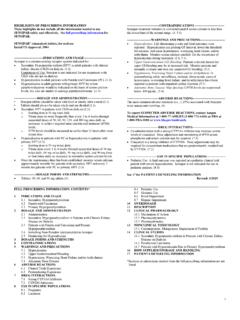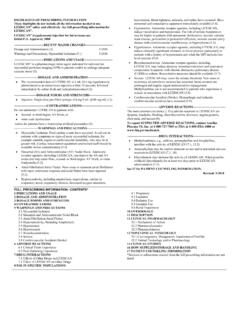Transcription of Brief Overview of Common Psychotropic Medications
1 Brief Overview of Common Psychotropic Medications : A Practical Guide from a Clinical Viewpoint Paula Bank, , Dept. of Psychiatry University of Michigan Medications FOR MOOD DISORDERS. SSRI Antidepressants- Use; Depressive and anxious disorders including Dysthymia, Major Depression, Panic Disorder, Generalized Anxiety Disorder, Obsessive Compulsive Disorder, Posttraumatic Stress Disorder, Separation Anxiety Disorder, Selective Mutism Mechanism of Action; Increased serotonin at brain neurons by blocking serotonin reuptake, long-term probably affect receptor numbers and distribution. Dosage unrelated to body weight. Side-Effects (most Common to all)-nausea, decreased appetite weight loss, excessive sweating, insomnia, jitteriness, sedation, dizziness, sexual dysfunction.
2 Note: The serotonergic syndrome is a medical emergency involving muscle jerking, tremor, high blood pressure, diarrhea and confusion due to drug interactions primarily with older antidepressants or similar drugs known as monoamine oxidase inhibitors. 1. Prozac (fluoxetine)-typically activating , available in liquid form. Dosage(child), mg/d . 2. Paxil (paroxetine)-typically sedating , available in liquid form. Has an associated withdrawal syndrome with abrupt discontinuation. Dosage (child), mg/d. 3. Zoloft (sertraline)-usually neither sedating or activating. Has milder withdrawal . syndrome with abrupt discontinuation. Dosage (child), mg/d. 4. Celexa (citalopram)-usually neither sedating or activating.
3 Extensive use in Europe during the development of Prozac market in the US. Advantage in few drug interactions, very good choice for medically ill children on multiple Medications . Available as a liquid, dosage (child) 5. Luvox (fluvoxamine)-Can be very sedating in children. Originally approved for obsessive compulsive disorder and the public frequent will present with the misconception that this medication is better than the other SSRI's for this indication. 6. Remeron (mirtazapine)-can be used as sleep aid at lower doses. Most frequent complaint is weight gain. Not used very often in children, dosage mg/d. Miscellaneous Antidepressants 1. Wellbutrin/Zyban (Buproprion)-also used for ADHD, smoking cessation and mood difficulties particularly in Bipolar patients.
4 May also be used to augment the action of other antidepressants. Mechanism of action involves increasing dopamine and norepinephrine turnover in the brain. Typical doses for children are between 100-200. mg/twice a day. Wellbutrin is not often used in young children, more frequently adolescents due to side effects including, agitation, insomnia, wt loss, constipation and tremor. More problematic in the increased risk for seizures in those with a seizure disorder, less risk with the slow-release form. 2. Effexor (Venlafaxine)-some believe may be helpful in ADHD and depression. Considered activating. Often used after other antidepressants fail. Mechanism of action also involves increased norepinephrine reuptake blockade as well as serotonin reuptake blockade.
5 Typical dosage of extended-release form for children would be 25-225 mg/day. At higher doses risk of elevated diastolic blood pressure that may become an issue in adolescent girls also on birth control pills. 3. Tricyclic acid antidepressants (TCA) including Tofranil (imipramine), Pamelor(nortriptyline), Anafranil (clomipramine), Elavil (amytriptyline)-use in children for ADHD is less Common than in recent past due to concerns for toxicity. TCA's are also used for headache prevention and pain syndromes. No really good gold standard studies showing effectiveness with depression/anxiety in kids. These Medications have largely been replaced by the SSRI's for treatment of depressive and anxiety disorders including Obsessive-Compulsive Disorder and PTSD.
6 Anafranil, however, may be used for Obsessive Compulsive Disorder in children with comorbid ADHD. Tofranil is approved for bedwetting. Doses vary for each TCA and some can be measured for actual blood levels. Side-effects for these Medications are numerous and include anticholinergic effects (dry mouth, blurred vision, constipation, difficulties with urination, fast heart rate, delirium and seizures), antihistamine effects (sleepiness, weight gain), alpha-1-receptor blockade (positional dizziness/BP. changes) and cardiac effects (slowed conduction through heart's electrical system). Sudden death has been reported in children taking both TCA's and stimulants. Baseline and frequent EKG monitoring are necessary when taking these medicines.
7 4. Monoamine Oxidase Inhibitors (MAOI)including), Nardil (phenylzine), Marplan (isocarboxazid) and Parnate (tranylcypromine). Rarely used Medications due to dietary restriction. Never used with SSRI since may precipitate a serotonergic crisis. 5. Desyrel (trazadone) Older antidepressant with sedation as a prominent side effect now used to treat insomnia. Mechanism of action involves blocking serotonin reuptake, alpha-1-adrenergic blockade and antihistamine action. Dosage is variable and generally adjusted to effect. In children may be used in younger ages even preschool/early graded, the developmentally delayed and/or autistic population for hyperactivity, impulsivity or sleep disturbance.
8 Doses typically are around mg up to three times per day. Some children, particularly in the DD population may be on very high doses of this medication . Worrisome side-effects are related to alpha- 1-adrenergic blockade and include cardiac arrythmias, positional low blood pressure, dry mouth, headache, constipation, priapism=prolonged erection-REQUIRES. EMERGENCY MEDICAL INTERVENTION. Mood Stabalizers-Use; Bipolar Affective Disorder (manic-depression), Aggression and Impulsivity. Not typically used for primary psychotic disorders unless there is suspicion of a mood component, ie. Schizoaffective Disorder. Some of these Medications are also used by neurologists for seizure disorders. 1. Depakote (Valproic Acid)-Currently thought to be the best choice for Bipolar patients with mixed states and rapid-cycling.
9 Bipolar children are frequently in these categories. Depakote is also used for migraine prevention. Typical dosages are based on weight up to about 20mg/kg/day. Doses are frequently divided into two or three times daily dosing. Blood chemistries and levels are obtained on a regular basis when using this medication due to the potentially serious life-threatening side-effects of liver and pancreatic damage as well as blood disorders. Side-effects are numerous and include sedation, dizziness, weight gain and hair loss. 2. Tegretol (Carbamazepine)- Similar indications as above except may be more frequently used for pain conditions and less for headache. Typical doses at about 10. mg/kg/day are also divided by two to four dosing intervals/day.
10 Has a very popular use for aggression and rage in children and some adults. Blood monitoring is necessary for levels as well as potentially fatal agranulocytosis/aplastic anemia and liver failure. 3. Eskalith (Lithium carbonate)-similar indications as above except thought to be the drug of choice for the treatment of acute mania especially in classic bipolar patients. Also needs frequent blood monitoring for levels and indicators of toxicity. Toxicity also includes thyroid/kidney concern, primarily long term. Also increased drinking and urination. 4. Miscellaneous Mood Stabalizers include Lamictal (lamotrigine) and Topamax (toprimate). There is some emerging evidence that Lamicatal might be helpful in Bipolar depressions.






